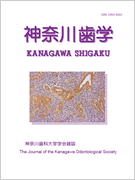- HOME
- > 一般の方
- > バックナンバー:神奈川歯学
- > 39巻1号
- > アブストラクト
アブストラクト(39巻1号:神奈川歯学)

Japanese
| Title : | 抗菌性モノマーMDPB配合試作接着システムからのフッ化物および臭化物イオンの象牙質への拡散 |
|---|---|
| Subtitle : | |
| Authors : | 海老原敬, 花岡孝治, 岡田周策, 寺中敏夫 |
| Authors(kana) : | |
| Organization : | 神奈川歯科大学歯科保存学講座 |
| Journal : | 神奈川歯学 |
| Volume : | 39 |
| Number : | 1 |
| Page : | 21-29 |
| Year/Month : | 2004 / 3 |
| Article : | 原著 |
| Publisher : | 神奈川歯科大学学会 |
| Abstract : | 現在の齲蝕治療は, 脱灰と再石灰化の繰り返しといった齲蝕の進行過程の解明と接着性修復材料の発達に伴い, G. V. Blackにより提唱された予防拡大の概念から脱却し, 歯質保存的な最小限の侵襲に基づく歯科治療(minimal Intervention Dentistry:MI)1)に移行している. MIの概念に適合した修復材料として, 接着性だけでなくフッ化物徐放能や抗菌性など生物学的活性を付与した機能性材料の開発が薦められている. とくに残存被着歯面と直接, 接触する象牙質接着システムに, これらの特性を付与した場合, より高い臨床的意義が期待される. 中でも, フッ素徐放性の接着システムでは, レジンー象牙質の接着界面を越えて, フッ化物イオン(F-)が経時的に歯質中へ拡散移行し, 耐酸性向上に伴う歯質強化や隣接する脱灰病巣の再石灰化が期待される. また, 抗菌性を付与した接着システムでは, 残存齲蝕細菌の無菌化や微少漏洩に起因する二次的な感染に対して非常に有効であると考えられる. |
| Practice : | 歯科学 |
| Keywords : | 抗菌性モノマー, フッ化物拡散, 象牙質接着 |
English
| Title : | Diffusion of Fluoride and Bromide Ions into Dentin from an Experimental Bonding System Containing an Antibacterial Monomer ‘MDPB’ |
|---|---|
| Subtitle : | |
| Authors : | Kei EBIHARA, Koji HANAOKA, Syusaku OKADA, Toshio TERANAKA |
| Authors(kana) : | |
| Organization : | Department of Operative Dentistry and Endodontics, Kanagawa Dental College |
| Journal : | Kanagawa Shigaku |
| Volume : | 39 |
| Number : | 1 |
| Page : | 21-29 |
| Year/Month : | 2004 / 3 |
| Article : | Original article |
| Publisher : | Kanagawa Odontological Society |
| Abstract : | The concept of minimal intervention dentistry (MI) has been accepted in place of the surgical approach proposed by G V Black. Recently, as adhesive materials for MI, the experimental dentin adhesive system (ABF) composed of a self- etching primer (ABP) incorporating antibacterial monomer, 12-methacryloyloxydodecylpyridiniumbromide (MDPB), and a bonding agent (KBF) containing special-treated NaF was developed. The purpose of this study was to evaluate the diffusion depth of fluoride ions (F-) and bromide ions (Br-) from this bio-functional ABF system into human coronal dentin and calcium ions (Ca2+) from the hybrid layer into the bonding layer. Exposed 5 × 7 mm human dentin slabs were conditioned with ABP for 20 sec and KBF was applied according to the manufacturers instructions. Then specimens were stored in 37℃ deionized water for 1 day, 1 week and 1 month. After each storage period, specimens were cut perpendicularly to the bonded surface. Elemental analysis was conducted by electron probe micro-analyzer (EPMA). results obtained are summarized as follows : 1. A hybrid layer approximately 1 um thick was revealed by SEM photomicrographs at the interface produced by the ABF system. Dense structures that might be estimated as special-treated NaF were observed at the hybrid layer-resin interface. 2. Significant increase (p<0.05) of F diffusion depth was demonstrated up to 1-week storage. The greatest amount of F- diffusion into dentin was found to be at 1-month storage. 3. The F- diffused from the ABF system formed insoluble fluoride near to the interface as time elapsed. 4. The Ca2+ diffused in the hybrid layer diffused into the bonding layer continuously. 5. The Br composing antibacterial component easily eluted in deionized water as Br-. |
| Practice : | Dentistry |
| Keywords : |
